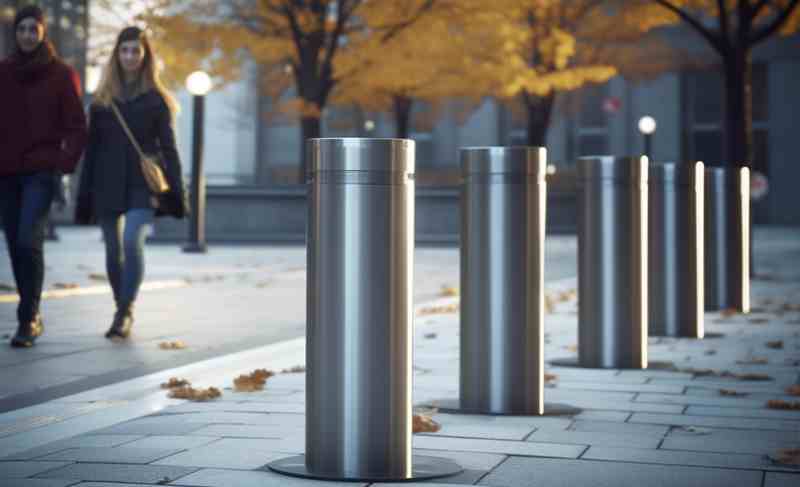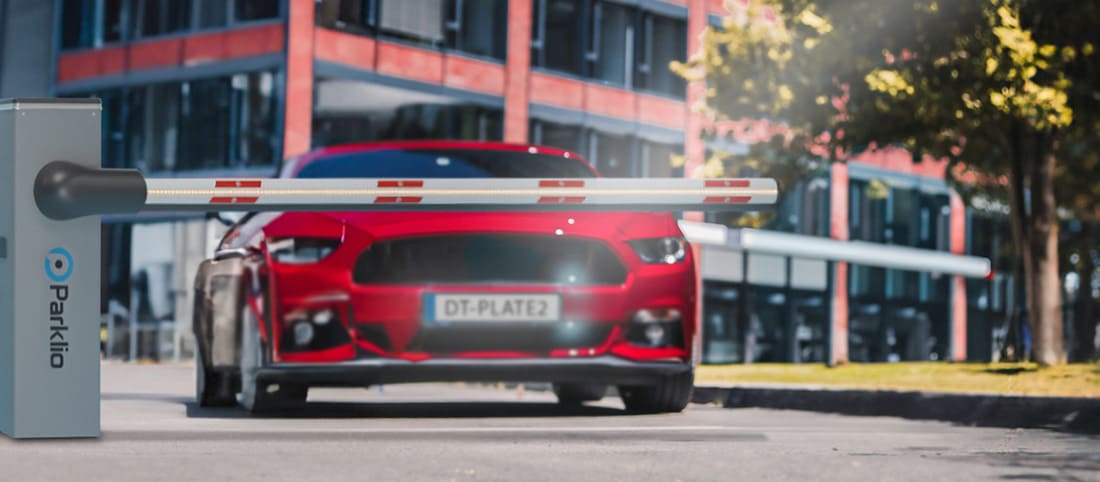Automatic Rising Bollards: Security and Aesthetics Aligned

Designed to prevent unauthorized vehicles from entering private, sensitive, or restricted areas, automatic bollards are known for their reliability, convenience, and safety. With the improvement of smart access control technology, they became a crucial element of our modern surroundings - a sleek security measure that found application in diverse settings where traditional fixed bollards and other types of parking protections are impractical.
Table of contents:
What are Automatic Bollards?
Automatic bollards, also known as rising or retractable bollards, are a type of barrier that can be raised or retracted into the ground, either remotely or automatically, in order to control the access of vehicles to a particular area.
Commonly used in urban centers, private parking areas, underground garages, and even government facilities, automatic bollards regulate traffic and improve security as they ensure a safe environment for pedestrians while still allowing access to authorized, emergency, and delivery vehicles.
The Key Advantages of Automatic Bollards
While the main purpose of an automatic bollard is protection, it also brings several benefits across various applications, such as:
Safety and Security
Automatic rising bollards form a physical barrier that prevents unauthorized vehicles from entering specified areas, such as busy pedestrian zones, high-profile facilities, and private properties. Besides preventing vehicular intrusion, automated bollards contribute to the safety of pedestrians, cyclists, and other road users as they help reduce the risk of accidents and collisions.
Traffic Control
Automatic bollards are typically installed in restricted traffic areas that require controlled access. By controlling access to certain roads or lanes, it is easier to manage congestion, regulate the number of vehicles passing through, and ensure that traffic runs smoothly.
Remote Control
Remote control enables individuals or authorized personnel to raise or lower the bollards from a distance using handheld remote controllers or a touch screen with a mobile app. This is especially convenient for security staff, property managers, and anybody else who wants to regulate access without manually removing the bollard each time they need to access the area.
Integration with Access Control Systems
Surveillance cameras and Automatic Number Plate Recognition Systems (ANPR) can be seamlessly integrated with automatic rising bollards to enhance their functionality and effectiveness, providing additional layers of access control and security.
Versatility and flexibility
One of the biggest advantages of these bollards is their ability to block vehicle access to an area while still allowing pedestrian access. Collapsing them takes just a few seconds and enables full access. Automatic rising bollards can also operate on a preset schedule, allowing for regulated access at certain times of the day or week. This flexibility is especially valuable in locations where access requirements change frequently.
Aesthetics
Many automatic rising bollards are aesthetically appealing and made to blend in with the surroundings. This is essential in urban areas where visual appeal is significant.
Durability and low maintenance
Most bollards today are built to last and require little maintenance. They are designed to survive harsh weather and heavy use, reducing the need for regular repairs. When regularly maintained, automatic bollards may last for many years and provide a very reliable option. When a high-quality automatic bollard is installed, it becomes a long-term solution for the facility.
LED lights safety system
An additional benefit of these bollards is their flashing lights. Installing lights on automated raising bollards can improve their visibility and effectiveness, particularly in low-light situations or at night. These lights can be used as a visual indicator to notify cars and pedestrians of the existence and status of bollards.
Also read: Why Is Parking Access Control Vital For Companies

How do Automatic Bollards work?
#1 Composition and Mechanism
Automatic rising bollards are typically constructed with a combination of strong materials such as stainless steel or aluminum to ensure durability and functionality. The three essential components of these bollards are the column part, the control system, and the actuator. In terms of the power system, automatic bollards can have pneumatic, hydraulic, or electric rising mechanisms that raise the bollard from a recessed location in the ground to an upright posture.
Electronic Bollard Mechanism: An electromotor is used to drive a shaft, which rises and lowers the bollard. In comparison to other mechanisms, electronically driven bollards provide the best precision and control while operating quietly.
Pneumatic Bollard Mechanism: Pneumatic motors use compressed air to move the cylinder upward, raising the bollard. This technology is cost-effective because it requires less maintenance.
Hydraulic Bollard Mechanism: A pump pushes an incompressible liquid into the cylinder to elevate bollards using hydraulic systems.
#2 Control Method
Automatic bollards can work just like any other access control barrier. Depending on the desired individual requirements, complexity, and features, different types of control systems can control these bollards. Remote controllers, simple timer-based systems, and vehicle identification systems, to name a few, are some of the most popular systems used for managing bollards; however, advanced systems often use mobile apps for operation.
#3 Rising and Lowering
The control system will receive a signal when a vehicle approaches an area with automatic raising bollards, either directly from the person who is operating the system or via a vehicle detection system like cameras or sensors. After authorization has been given to the vehicle or individual, the control system sends a signal to lower the bollards, enabling the vehicle to proceed. Once the vehicle has successfully passed through, the bollards revert to their upright position automatically, restoring regular traffic conditions.
It's important to recognize that the features and capabilities of automatic telescopic bollards can differ based on the manufacturer and their intended use, which means that various models may differ when it comes to speed, power supply, control systems, and safety features.
Considerations for installation
What you want to protect and the behavior you want to prevent should guide your choice of bollard. Here are some key considerations to keep in mind:
-
Evaluate the area where you would like to install bollards. Take into account factors such as the flow of traffic, movement of pedestrians, accessibility needs, and the ability of emergency vehicles to access the area.
-
Consider the length of the bollard, ground stability, and previous installations. The soft or unstable ground may demand extra reinforcement or specialized installation techniques to secure the bollards. It's also vital to assess potential conflicts with existing underground installations like utilities or infrastructure.
-
Define the objectives and purpose of the bollards. Are they intended to prevent unauthorized access, provide additional security, or enable traffic control?
-
Determine the required level of security. Are the bollards intended to stop unauthorized vehicles from entering or control vehicle entry during specific hours?
-
Make sure the bollards are compatible with existing or planned security infrastructure if they are to be used as part of an access control system.
-
Determine how you would like to control the bollards. The chosen control method should be compatible with the site's security and operational requirements.
-
Decide what kind of power source you are going to use, an electrical grid or perhaps a solar panel.
By carefully considering these factors, you can ensure that the installation of automatic rising bollards is successful, corresponds with your goals, and contributes to the safety and security of the area.

A Blend of Sophisticated Design and High-Level Protection
In conclusion, automatic rising bollards provide a comprehensive solution that combines security, convenience, and efficiency. By effectively controlling and preventing unauthorized access, enhancing safety, and aligning with aesthetic aspects of the location, these bollards contribute significantly to safeguarding sensitive areas and public spaces.
Integrating elements like cameras and license plate recognition systems expands their capabilities, resulting in a fully automated security system. However, careful consideration of installation and maintenance expenses is required to maximize the benefits of these flexible systems.


